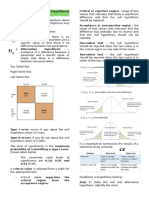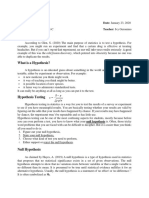0 ratings0% found this document useful (0 votes)
1 viewsChapter 4 Notes
The document discusses the process of experimentation, emphasizing the importance of confirming or rejecting hypotheses through well-designed tests. It outlines the concepts of false confirmation (Type 2 Error) and false rejection (Type 1 Error), as well as the role of the null hypothesis in these processes. Additionally, it provides guidelines for designing tests to minimize the risk of errors and ensure clarity in claims being tested.
Uploaded by
ethanbeamCopyright
© © All Rights Reserved
Available Formats
Download as DOCX, PDF, TXT or read online on Scribd
0 ratings0% found this document useful (0 votes)
1 viewsChapter 4 Notes
The document discusses the process of experimentation, emphasizing the importance of confirming or rejecting hypotheses through well-designed tests. It outlines the concepts of false confirmation (Type 2 Error) and false rejection (Type 1 Error), as well as the role of the null hypothesis in these processes. Additionally, it provides guidelines for designing tests to minimize the risk of errors and ensure clarity in claims being tested.
Uploaded by
ethanbeamCopyright
© © All Rights Reserved
Available Formats
Download as DOCX, PDF, TXT or read online on Scribd
You are on page 1/ 1
Experimentation
Experimentation
-Hypotheses are confirmed or rejected by testing predictions made about the hypothesis
Confirmation and Rejection
-A well designed experiment will control for factors that could lead to a false confirmation or rejection of
the claim being tested
-False confirmation: could the predicted outcome be due to anything other than the claim at issue?
-If yes, the experiment cannot verify the claim
-aka False Negative, or Type 2 Error
-Fails to detect an effect that is present
-False rejection: could the predicted outcome fail to occur even if the claim at issue is correct?
-aka False Positive or Type 1 Error
-Detecting an effect that is not actually present
-Leads you
-Null hypothesis
-Refers to a general statement or default position that there is no relationship between two measure
phenomena
-Often denoted H^0
-False confirmation/false negative/type 2 error is the failure to reject a false null hypothesis
-False rejection/false positive/type 1 error is the incorrect rejection of a true null hypothesis
Designing a Test
-A good test will be designed to rule out the possibility of a false confirmation or rejection
1. Can the possibility of a false rejection be ruled out?
2. Can the possibility of a false confirmation be ruled out?
3. Is the claim at issue conceptually clear?
4. Is the difference between predictive success and failure clearly specified?
5. Have controls been imposed to eliminate the influence of experimenter or experimental subject
expectations?
You might also like
- Suitability For Short-Term Cognitive Therapy Rating Scales75% (4)Suitability For Short-Term Cognitive Therapy Rating Scales4 pages
- Corrections Situation Judgement Practice WorkbookFrom EverandCorrections Situation Judgement Practice WorkbookNo ratings yet
- Hypothesis Testing and P Value: BY DR Zahid Khan Senior Lecturer King Faisal University, KSANo ratings yetHypothesis Testing and P Value: BY DR Zahid Khan Senior Lecturer King Faisal University, KSA16 pages
- Pcba116 Module No. 7 Hypothesis TestingNo ratings yetPcba116 Module No. 7 Hypothesis Testing18 pages
- Dealing With Variables and Hypotheses - Lecture 2 FinalNo ratings yetDealing With Variables and Hypotheses - Lecture 2 Final56 pages
- The Concept of Sensitivity and Specificity in Relation To Two Types of Errors and Its Application in Medical ResearchNo ratings yetThe Concept of Sensitivity and Specificity in Relation To Two Types of Errors and Its Application in Medical Research6 pages
- A Beginners Guide To Hypothesis Testing - Hypothesis Made Simple - Data Dojo - Data Analytics With Sunil KappalNo ratings yetA Beginners Guide To Hypothesis Testing - Hypothesis Made Simple - Data Dojo - Data Analytics With Sunil Kappal5 pages
- Stat 130n-Answers To LAs in Lessons 5.1-5.3No ratings yetStat 130n-Answers To LAs in Lessons 5.1-5.318 pages
- Scientific Thinking: DR/ Shaimaa Elgendy Lecture (2)No ratings yetScientific Thinking: DR/ Shaimaa Elgendy Lecture (2)15 pages
- Stating Hypothesis, Study Questions and Formulating Objectives-1No ratings yetStating Hypothesis, Study Questions and Formulating Objectives-126 pages
- X. Understanding Hypothesis Testing PDFNo ratings yetX. Understanding Hypothesis Testing PDF38 pages
- Module 4 Parametric Vs Non Parametric TestNo ratings yetModule 4 Parametric Vs Non Parametric Test7 pages
- (L3.2) - Hypothesis Testing - Type I and Type II ErrorNo ratings yet(L3.2) - Hypothesis Testing - Type I and Type II Error16 pages
- a78bde04-1efd-4ff1-9e48-b23104cd7c3b (1)No ratings yeta78bde04-1efd-4ff1-9e48-b23104cd7c3b (1)10 pages
- Lesson 6.1 Hypothesis Testing One Sample TestNo ratings yetLesson 6.1 Hypothesis Testing One Sample Test14 pages
- 08-Screening and Surveillance 2023 DR - ALSaidiNo ratings yet08-Screening and Surveillance 2023 DR - ALSaidi54 pages
- Hypothesis Testing: Step 1: State Your Null and Alternate HypothesisNo ratings yetHypothesis Testing: Step 1: State Your Null and Alternate Hypothesis6 pages
- Fails To Reject Is: Potential Errors in The Statistical Decision-Making ProcessNo ratings yetFails To Reject Is: Potential Errors in The Statistical Decision-Making Process2 pages
- Biostatistics Assignment Hypothesis TestingNo ratings yetBiostatistics Assignment Hypothesis Testing5 pages



























































